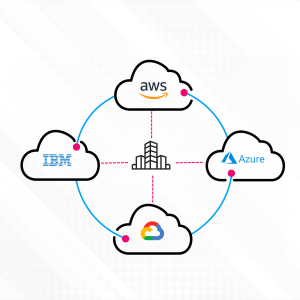Introduction to Multi-Cloud/Introduction: The Rise of Cloud Technology
In today’s fast-paced digital landscape, cloud technology has firmly established itself as an indispensable tool for companies to develop adaptable, scalable, secure, and efficient technological solutions capable of addressing evolving business needs.
Large companies such as Google, Microsoft, Amazon, IBM and many others have democratized access to cloud services, making previously unattainable computing capabilities accessible to both businesses and individuals.
However, as cloud technology evolves, so do the strategies for harnessing its power. Different integration approaches and architectures have emerged to fully exploit the cloud’s potential, including connecting on-premise and cloud environments, bridging private and public clouds, and collaborating with multiple cloud service vendors.

We will focus on this last scenario.
Understanding Multi-Cloud Architecture
This Hybrid Multi-Cloud architecture refers to a system combining the services of two or more cloud providers working together into a unified ecosystem, leveraging each provider’s unique strengths, region availability and capabilities.
With numerous cloud providers offering various services, pricing models, and geographic availability, Multi-Cloud architecture has emerged as a strategic choice for businesses looking to maximize the potential of the cloud.
Why choose Multi-cloud?
Businesses are rapidly adopting this architectural approach for several reasons:
-
Enhanced Security: Mitigating Risks and Fortifying Infrastructure
This kind of architecture improves the system security in multiple ways. It mitigates risks by allowing workloads distributed across different cloud providers, ensuring that if one encounters issues, others can seamlessly take over. Additionally, it helps tackle “Shadow IT”, the use of unauthorized or unapproved technology solutions, applications, or services within an organization by employees, providing them with different cloud-based secure alternatives. Choosing cloud over on-premise software helps to avoid “Shadow IT”, while security and lack of governance risks can be significantly reduced. This architecture also adds extra resilience and redundancy, hardening overall application robustness.
-
Unmatched Flexibility: Breaking Free from Vendor Lock-ins
Cloud providers often offer similar products, but on certain occasions, some unique products and differences can be critical when choosing one over another. Multi-Cloud allows administrators to select the tools that best align with their specific needs, promoting closer alignment to business requirements. It also allows you to choose each provider’s most powerful products and combine those to create a more robust solution.
-
Proximity and Compliance: Navigating Data Regulation and Geographical Challenges
High availability and fast response time are paramount in modern systems. Multi-cloud environments ensure multiple endpoints, optimizing response times by directing requests to the closest data center. Moreover, they facilitate compliance with data sovereignty laws and regulations, enabling services in regions where certain cloud providers may be restricted.
The Rise of Multi-Cloud Implementations
There are many other reasons why Multi-Cloud implementations are gaining popularity among companies seeking to improve security and performance while building robust applications or solutions with high availability, hybrid workflows and seamless DevOps integration. This approach recognizes that the cloud landscape is continually evolving. With providers improving their services or pricing models, deciding to rely on a single provider for a significant project is increasingly challenging.
In conclusion, The Future is Multi-Cloud
Julio Cesar’s wisdom, “Divide and conquer”, becomes particularly relevant here. In the short term, the benefits mentioned above make a strong case for Multi-cloud architecture. Although some can also be achieved with a Hybrid Cloud model, combining private and public clouds, there are strong reasons to believe that leveraging multiple clouds will result in more agile, secure and reliable systems.
Embrace the Multi-Cloud Revolution by Making Science and Propel Your Business to New Heights!
Transform your business with the power of multi-cloud, guided by the expertise of Making Science. Our team of certified experts are here to help you achieve real-world advantages by addressing complex challenges, streamlining operations and driving innovation that translates into measurable benefits for your business.








 Cookie configuration
Cookie configuration